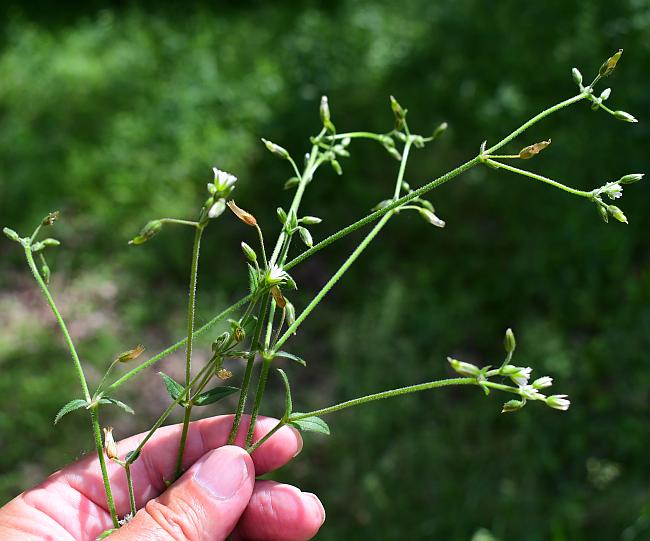Cerastium fontanum Baumg.
Common Mouse-Eared Chickweed

Introduced
CC = *
CW = 3
MOC = 61
© SRTurner
Cerastium fontanum Baumg.Common Mouse-Eared Chickweed | |
 |
Introduced CC = * CW = 3 MOC = 61 |
© SRTurner |
|
Family - Caryophyllaceae Habit - Taprooted forb, usually perennial. Stems - Sprawling to erect, 10-65 cm, often from a spreading base, usually branched above the midpoint, moderately to densely pubescent with usually straight, nonglandular hairs, occasionally also stipitate-glandular in the inflorescence.
Leaves - Opposite, simple, sessile. Blades 0.5-4.0 cm long, spatulate (some basal leaves) or narrowly ovate to oval, angled to a bluntly pointed tip.
Inflorescences - Open panicles, the stalks 0.4-1.0 cm long, 1-2 times as long as the sepals, ascending but usually somewhat curved above the midpoint at flowering and fruiting, densely pubescent with nonglandular hairs, occasionally also with stalked glands, the bracts green, the upper bracts with narrow, thin, white to translucent margins.
Flowers - Sepals 5, 4-7 mm long, ovate-lanceolate, angled or tapered to a sharply pointed tip, green, densely pubescent with nonglandular hairs, rarely also stipitate-glandular, the hairs usually not extending past the sepal tips. Sepal margins thin and translucent. Petals 5, 4-5 mm long, 0.6-1.0 times as long as the sepals, deeply 2-lobed (often to the midpoint) at the tip, the veins usually not apparent. Stamens 10. Styles 5.
Fruits - Capsules 8-11 mm long, 1-2 times as long as the sepals, curved. Seeds 0.6-0.9 mm wide, the surface tuberculate, brown.
Flowering - April - October. Habitat - Sloughs, pond margins, streambanks, ledges of bluffs, sand prairies, pastures, fields, ditches, lawns, gardens, railroads, roadsides, open, disturbed areas. Origin - Native to Europe. Lookalikes - Other small-flowered species of Cerastium. Other info. - The small-flowered species of Cerastium are routinely ignored by all but the most attentive of botanists. They are small, unimpressive, and generally weedy in aspect. Identification is not particularly difficult but requires close attention to detail. C. fontanum is characterized by open inflorescences, sepals which are hairy but not glandular, upper bracts having thin translucent margins, and flowers mostly having 10 stamens. It occurs throughout Missouri, and most of the continental U.S., though less commonly in the Gulf Coast and central Plains states. Photographs taken at Weldon Spring Conservation Area, St. Charles County, MO, 5-31-2020, and at Shaw Nature Reserve, Franklin County, MO, 5-31-2021 (SRTurner). |